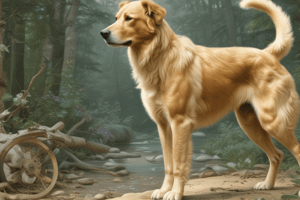Podcast
Questions and Answers
What is the primary focus of botany?
What is the primary focus of botany?
- Study of human anatomy
- Study of plant life and their processes (correct)
- Study of animal behavior
- Study of geological formations
Which subfield of zoology focuses on reptiles and amphibians?
Which subfield of zoology focuses on reptiles and amphibians?
- Ethology
- Entomology
- Herpetology (correct)
- Mammalogy
Which process do plants use to convert sunlight into energy?
Which process do plants use to convert sunlight into energy?
- Photosynthesis (correct)
- Metabolism
- Respiration
- Fermentation
What is a unique feature of plant cells?
What is a unique feature of plant cells?
Which subfield studies the classification and naming of plants?
Which subfield studies the classification and naming of plants?
What does ethology study in the context of zoology?
What does ethology study in the context of zoology?
How do botany and zoology fields often overlap?
How do botany and zoology fields often overlap?
What key concept in zoology studies the origins and changes in animal species over time?
What key concept in zoology studies the origins and changes in animal species over time?
Flashcards
Botany
Botany
The scientific study of plants, including their structure, properties, and biochemical processes.
Plant Physiology
Plant Physiology
Study of plant functions and life processes.
Plant Taxonomy
Plant Taxonomy
Classification and naming of plants.
Plant Ecology
Plant Ecology
Signup and view all the flashcards
Zoology
Zoology
Signup and view all the flashcards
Ethology
Ethology
Signup and view all the flashcards
Entomology
Entomology
Signup and view all the flashcards
Ecological Role
Ecological Role
Signup and view all the flashcards
Study Notes
Botany
- Definition: The scientific study of plants, including their structure, properties, and biochemical processes.
- Subfields:
- Plant Physiology: Study of plant functions and life processes.
- Plant Taxonomy: Classification and naming of plants.
- Plant Ecology: Interactions between plants and their environment.
- Mycology: Study of fungi, which are not plants but often studied alongside botany.
- Key Concepts:
- Photosynthesis: Process by which plants convert sunlight into energy.
- Genetics: Study of heredity and variation in plants.
- Plant Cells: Unique features include cell walls, chloroplasts, and large central vacuoles.
- Reproductive Strategies: Sexual (seeds, flowers) and asexual (cloning, cuttings).
Zoology
- Definition: The scientific study of animals, including their biology, behavior, evolution, and classification.
- Subfields:
- Ethology: Study of animal behavior.
- Entomology: Study of insects.
- Herpetology: Study of reptiles and amphibians.
- Mammalogy: Study of mammals.
- Key Concepts:
- Animal Physiology: Processes and functions of animal bodies.
- Animal Behavior: How animals interact with each other and their environments.
- Evolution: Study of the origins and changes in animal species over time.
- Habitat: Natural environment where an organism lives, which affects its survival and reproduction.
Comparison
- Focus Areas:
- Botany: Primarily on plant life and their processes.
- Zoology: Focus on animal life, behavior, and physiology.
- Methodologies:
- Both fields utilize observation, experimentation, and classification.
- Interdisciplinary Links:
- Botany and zoology often overlap in areas like ecology, environmental science, and conservation biology.
Importance
- Ecological Role: Understanding both fields is crucial for ecosystem management and biodiversity conservation.
- Human Impact: Research in botany and zoology aids agriculture, medicine, and environmental restoration.
Botany
- Study of plants, including structure, properties, and processes.
- Subfields include:
- Plant Physiology: Focuses on plant life processes and functions.
- Plant Taxonomy: Classifies and names plants.
- Plant Ecology: Examines interactions between plants and their environments.
- Mycology: The study of fungi, often alongside botany.
- Key Concepts:
- Photosynthesis: The process plants use to convert sunlight into energy.
- Genetics: Studies heredity and variation in plants.
- Plant Cells: Distinctive features include cell walls, chloroplasts, and a large central vacuole.
- Reproduction: Both sexual (seeds, flowers) and asexual (cloning, cuttings) methods are used.
Zoology
- Study of animals, covering biology, behavior, evolution, and classification.
- Subfields include:
- Ethology: Study of animal behavior.
- Entomology: Study of insects.
- Herpetology: Study of reptiles and amphibians.
- Mammalogy: Study of mammals.
- Key Concepts:
- Animal Physiology: Processes and functions of animal bodies.
- Animal Behavior: How animals interact with each other and their environment.
- Evolution: Study of the origins and changes in animal species over time.
- Habitat: The natural environment where an organism lives, influencing survival and reproduction.
Comparison
- Focus Areas:
- Botany: Primarily focuses on plant life and their processes.
- Zoology: Focuses on animal life, behavior, and physiology.
- Methodologies:
- Both fields utilize observation, experimentation, and classification.
- Interdisciplinary Links:
- Both fields frequently overlap in areas like ecology, environmental science, and conservation biology.
Importance
- Ecological Role: Understanding both fields is vital for ecosystem management and biodiversity conservation.
- Human Impact: Research in botany and zoology aids agriculture, medicine, and environmental restoration.
Studying That Suits You
Use AI to generate personalized quizzes and flashcards to suit your learning preferences.




